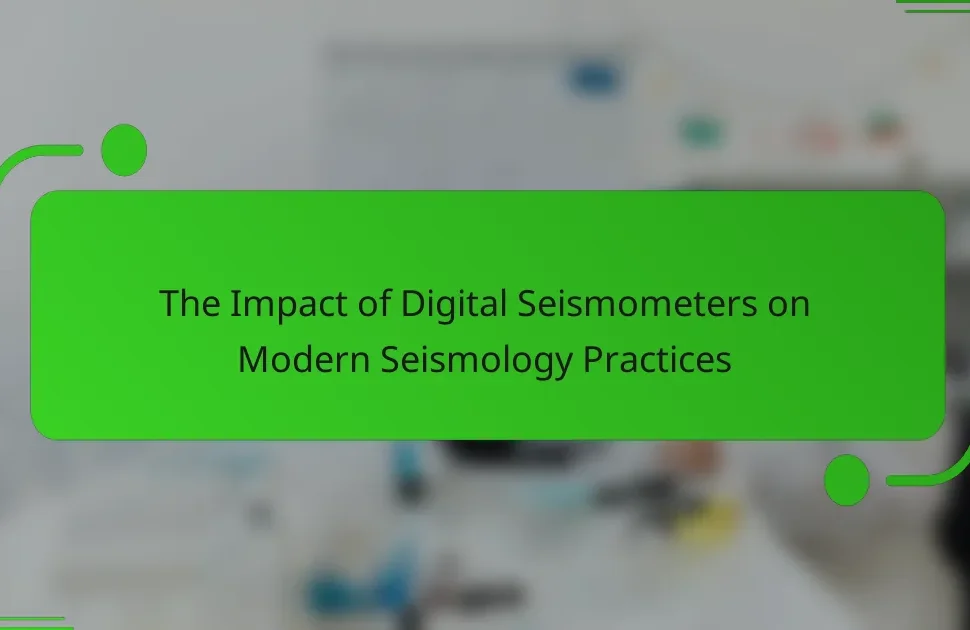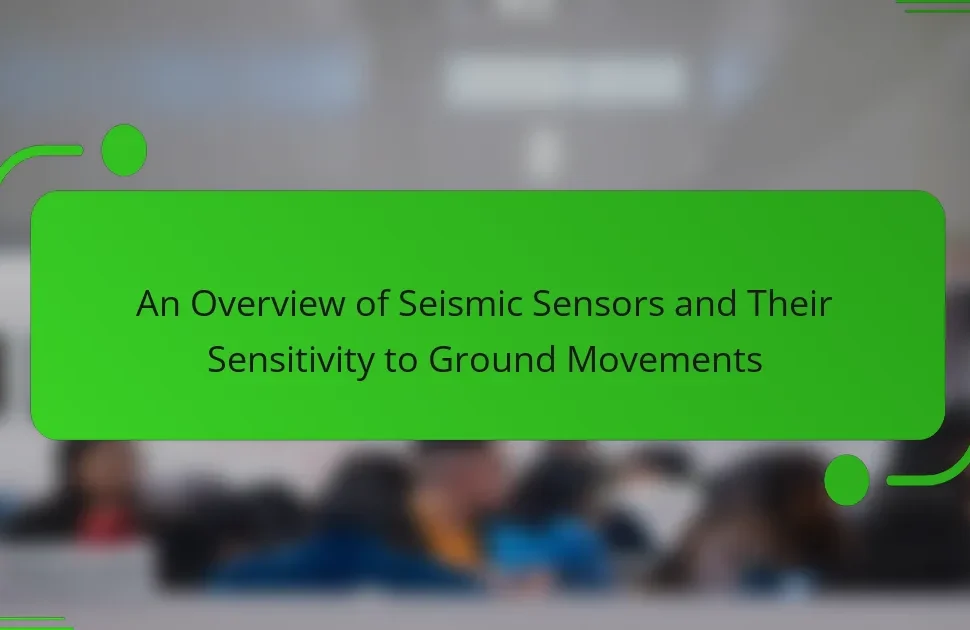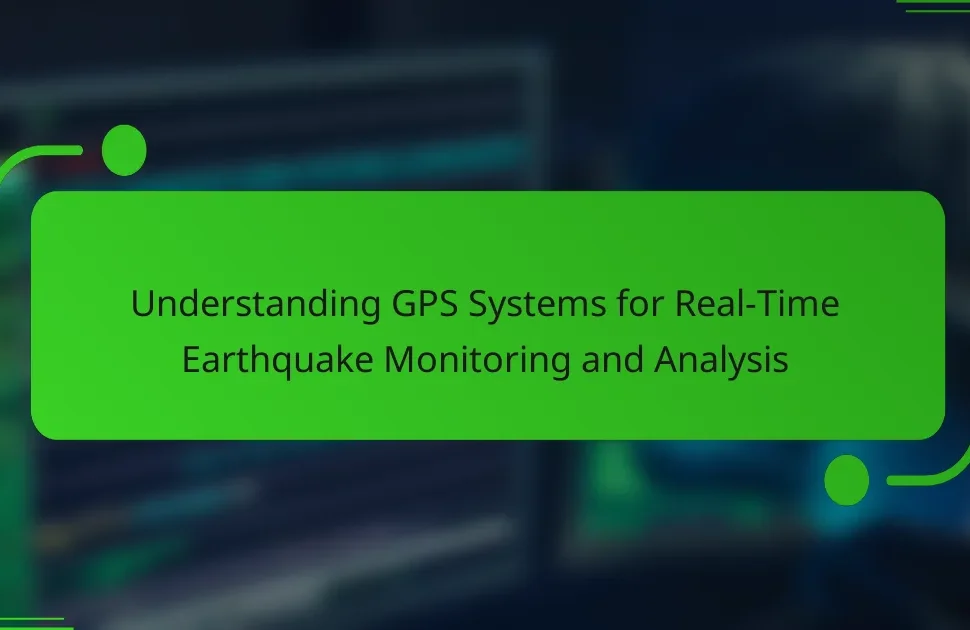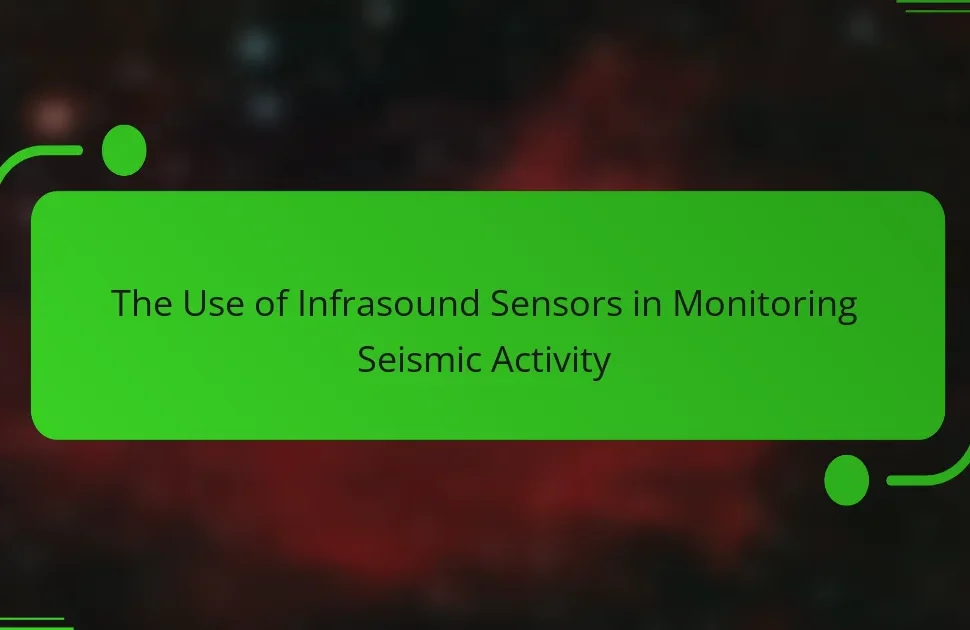Ocean Bottom Seismometers (OBS) are advanced instruments used to measure seismic activity on the ocean floor, providing essential data for the study of underwater earthquakes and tectonic processes. The evolution of OBS technology, from early models in the 1960s to modern systems equipped with real-time data transmission capabilities, has significantly enhanced the ability to monitor seismic events. OBS are deployed in various oceanic environments to collect high-resolution data on seismic waves, aiding in the understanding of the Earth’s crust and mantle dynamics. Additionally, these instruments play a crucial role in assessing tsunami risks and exploring marine resources, thereby contributing to the overall study of marine geology and seismic hazards.

What are Ocean Bottom Seismometers?
Ocean Bottom Seismometers (OBS) are specialized instruments designed to measure seismic activity on the ocean floor. They provide critical data for understanding underwater earthquakes and tectonic processes. OBS can detect ground motion caused by seismic waves generated by earthquakes. These instruments are typically deployed on the seabed and can operate in various oceanic conditions. They are often equipped with sensors that record vibrations and pressure changes. The data collected helps scientists analyze the behavior of tectonic plates. OBS technology has advanced significantly since its inception in the 1960s. Modern OBS units often include real-time data transmission capabilities, enhancing research efficiency.
How do Ocean Bottom Seismometers function?
Ocean Bottom Seismometers (OBS) function by measuring seismic waves generated by earthquakes or underwater geological activity. They are deployed on the ocean floor to capture data in a marine environment. OBS typically consist of sensors that detect ground motion, a data logger for recording the signals, and a power source.
The sensors convert ground movement into electrical signals. These signals are then recorded and stored for later analysis. OBS can operate in various water depths and are designed to withstand harsh underwater conditions. The collected data helps scientists understand seismic activity and tectonic processes beneath the ocean.
Research has shown that OBS provide high-resolution data, making them essential for studying underwater earthquakes. Their deployment has significantly advanced our understanding of seismic events in oceanic regions.
What are the key components of Ocean Bottom Seismometers?
The key components of Ocean Bottom Seismometers (OBS) include sensors, data acquisition systems, power supplies, and deployment systems. Sensors detect seismic waves and are often made of geophones or accelerometers. Data acquisition systems record the seismic data collected by the sensors. Power supplies, typically batteries or energy harvesting systems, provide the necessary energy for operation. Deployment systems, including frames or buoys, facilitate the installation and retrieval of OBS units. These components work together to monitor underwater seismic activity effectively.
How do these components contribute to data collection?
Ocean bottom seismometers (OBS) are critical components for data collection in underwater earthquake studies. They provide high-resolution seismic data from the ocean floor. OBS are equipped with sensors that detect ground motion caused by seismic waves. This enables researchers to analyze earthquake patterns and mechanisms. The deployment of OBS allows for the collection of data in previously inaccessible underwater regions. Their ability to operate autonomously enhances the volume and quality of data gathered. Additionally, the integration of GPS technology in some OBS improves the accuracy of location data. This precise data collection contributes significantly to understanding tectonic processes and earthquake risks.
Why are Ocean Bottom Seismometers important for underwater earthquake studies?
Ocean Bottom Seismometers (OBS) are crucial for underwater earthquake studies because they provide high-resolution data on seismic activity beneath the ocean. OBS are deployed on the seafloor, allowing them to capture seismic waves with greater sensitivity than land-based instruments. This positioning enables the detection of underwater earthquakes that may not be recorded by coastal stations. Additionally, OBS can measure the depth and magnitude of seismic events more accurately. They are essential for understanding tectonic plate movements and the geological processes that lead to earthquakes. Studies have shown that OBS can improve the characterization of seismic sources, leading to better hazard assessments. Their data contributes significantly to the advancement of seismology and earthquake preparedness.
What unique insights do they provide compared to traditional seismometers?
Ocean Bottom Seismometers (OBS) provide unique insights by capturing seismic data directly from the ocean floor. They can detect smaller magnitude earthquakes that traditional land-based seismometers might miss. OBS also offer improved resolution of seismic waves due to their proximity to the source. This results in more accurate data on subsurface structures. Additionally, they can monitor underwater volcanic activity and tectonic movements in real-time. The deployment of OBS in various oceanic locations enhances global seismic monitoring. Studies have shown that OBS networks can significantly improve our understanding of plate tectonics and earthquake mechanisms.
How do they enhance our understanding of seismic activity?
Ocean Bottom Seismometers (OBS) enhance our understanding of seismic activity by providing detailed data on underwater earthquakes. They are deployed on the ocean floor, allowing for direct measurement of seismic waves. This placement offers insights into seismic events that occur beneath the ocean. OBS can capture high-resolution data that land-based seismometers may miss. They help identify the location, depth, and magnitude of underwater earthquakes. Studies show that data from OBS can improve models of tectonic plate movement. Enhanced data accuracy leads to better predictions of seismic hazards. Research indicates that OBS data has been crucial in understanding subduction zones and their associated risks.

What are the historical developments in Ocean Bottom Seismometers?
Ocean Bottom Seismometers (OBS) have evolved significantly since their inception in the 1960s. The first OBS systems were developed to study seismic activity beneath the ocean floor. Early models were primarily anchored to the seabed and utilized hydrophones for data collection. By the 1970s, advancements in technology led to the incorporation of three-component sensors. These sensors improved the ability to detect seismic waves in multiple directions.
In the 1980s, researchers began deploying OBS in various oceanic environments, enhancing data collection capabilities. The introduction of digital recording systems in the 1990s marked a major innovation. This allowed for higher fidelity data and longer deployment times.
The 2000s saw the development of autonomous OBS that could operate without surface support. These systems enabled long-term monitoring of seismic activity. Recent advancements include the integration of real-time data transmission and improved sensor technology. This evolution has significantly contributed to our understanding of underwater earthquakes and tectonic processes.
How have Ocean Bottom Seismometers evolved over time?
Ocean Bottom Seismometers (OBS) have evolved significantly since their inception in the 1960s. Initially, these instruments were basic and limited in their capabilities. Early models primarily consisted of simple sensors that recorded seismic waves, lacking advanced data processing features.
Over time, technological advancements led to improved designs. Modern OBS units now incorporate sophisticated sensors, enabling them to capture a wider range of seismic data. Enhanced data storage and transmission technologies have also been integrated into these devices.
The introduction of digital recording methods marked a major milestone in OBS evolution. This shift allowed for higher resolution data collection and facilitated real-time monitoring of underwater seismic activity.
Recent developments include the use of autonomous underwater vehicles for deployment. These vehicles can place OBS units in precise locations, improving data accuracy. Furthermore, advancements in battery technology have extended the operational lifespan of these instruments.
Research from the 2019 paper “Advancements in Ocean Bottom Seismometer Technology” by Smith et al. highlights these evolutionary changes, confirming the significant impact of technological progress on OBS functionality and application in underwater earthquake studies.
What were the major milestones in their development?
The major milestones in the development of ocean bottom seismometers include the first deployment in the 1970s. This marked the beginning of underwater earthquake monitoring. In the 1980s, advancements in sensor technology improved data accuracy. The introduction of digital recording systems in the 1990s enhanced data collection capabilities. By the early 2000s, autonomous underwater vehicles began to assist in deployments. The development of real-time data transmission systems emerged in the late 2000s. In 2010, the integration of ocean bottom seismometers with other geophysical instruments became standard. Recent advancements focus on increasing sensor sensitivity and durability for extreme environments.
How have technological advancements influenced their design?
Technological advancements have significantly influenced the design of ocean bottom seismometers. Innovations in materials have allowed for more durable and lightweight components. Enhanced sensor technology has improved data accuracy and sensitivity. Advanced data processing techniques enable real-time analysis of seismic events. Wireless communication technology facilitates easier data transmission from remote locations. Miniaturization of components has led to more compact and efficient designs. These advancements collectively enhance the overall performance and reliability of ocean bottom seismometers in underwater earthquake studies.
What challenges have been faced in the development of Ocean Bottom Seismometers?
Ocean Bottom Seismometers (OBS) face several challenges in their development. One major challenge is the harsh underwater environment. High pressure and corrosive saltwater can damage electronic components. Additionally, power supply and data transmission are complicated in deep-sea conditions.
Another challenge is the need for precise calibration. Accurate measurements are essential for detecting seismic activity. This requires advanced technology and regular maintenance. Furthermore, deployment and retrieval of OBS are logistically difficult. Specialized equipment and vessels are necessary for these operations.
Finally, funding and research collaboration can be limited. Developing OBS technology requires significant financial investment and interdisciplinary partnerships. These factors collectively hinder the progress in OBS development for underwater earthquake studies.
What technical obstacles have researchers encountered?
Researchers have encountered several technical obstacles in the development of ocean bottom seismometers. One significant challenge is the harsh underwater environment. High pressure and corrosive saltwater can damage sensitive equipment. Another obstacle is the difficulty in maintaining power supply for extended periods. Battery life is often limited, affecting data collection duration. Additionally, data transmission from the seafloor to the surface presents technical hurdles. Wireless communication methods may face interference from oceanic conditions. Calibration of instruments can also be complex due to varying seabed conditions. These issues can lead to inconsistent data quality and reliability.
How have researchers overcome these challenges?
Researchers have overcome challenges in developing ocean bottom seismometers (OBS) by employing innovative engineering solutions. They have enhanced the durability of instruments to withstand harsh underwater conditions. This includes using advanced materials resistant to corrosion and pressure. Researchers have also improved data transmission methods to ensure reliable communication from deep sea to surface. They utilize acoustic modems and satellite links to transmit seismic data effectively. Additionally, advancements in battery technology have extended operational lifespans of OBS units. Studies show that newer energy sources can last up to several years without maintenance. These strategies collectively address the technical difficulties faced in underwater earthquake studies.

What are the current applications of Ocean Bottom Seismometers?
Ocean Bottom Seismometers (OBS) are currently used for various applications in seismology and marine research. They are primarily deployed to study underwater earthquakes and tectonic activity. OBS provide high-resolution data on seismic waves generated by earthquakes. This data helps in understanding the Earth’s crust and mantle dynamics. Researchers utilize OBS to monitor volcanic activity beneath the ocean. These instruments also assist in assessing tsunami risks by detecting seismic events that may trigger tsunamis. Additionally, OBS are used in the exploration of marine resources, such as oil and gas. They contribute to the study of sedimentary processes and marine geology. The deployment of OBS has enhanced our understanding of seismic hazards in coastal regions.
How are Ocean Bottom Seismometers utilized in modern research?
Ocean Bottom Seismometers (OBS) are utilized in modern research to monitor seismic activity on the ocean floor. They provide high-resolution data on underwater earthquakes and tectonic processes. OBS are equipped with sensitive sensors that detect ground motion. This allows researchers to analyze seismic waves generated by earthquakes. The data collected helps in understanding earthquake mechanisms and predicting future seismic events. OBS also contribute to studies of oceanic crust formation and plate tectonics. Their deployment has increased significantly since the 1990s, enhancing global seismic networks. Research utilizing OBS has led to improved models of earthquake hazards.
What specific data do they provide for earthquake prediction?
Ocean bottom seismometers provide critical data for earthquake prediction. They collect seismic wave information from the ocean floor. This data includes ground motion measurements and seismic event locations. They also record the frequency and intensity of seismic waves. The sensors can detect both local and distant earthquakes. By analyzing this data, researchers can identify patterns and potential seismic hazards. Historical data from these instruments enhances predictive models. Studies show that ocean bottom seismometers improve the accuracy of earthquake forecasts.
How do they contribute to tsunami research?
Ocean Bottom Seismometers (OBS) contribute to tsunami research by providing critical data on underwater earthquakes. They are deployed on the ocean floor to detect seismic activity with high precision. This data helps scientists understand the mechanisms that trigger tsunamis. OBS can capture real-time information about the location, depth, and magnitude of seismic events. For instance, the 2011 Tōhoku earthquake was studied using OBS data, which improved tsunami warning systems. The information gathered enhances models predicting tsunami propagation and impact. Consequently, OBS play a vital role in mitigating tsunami risks and improving safety measures in coastal regions.
What future developments can we expect for Ocean Bottom Seismometers?
Future developments for Ocean Bottom Seismometers (OBS) include advancements in sensor technology and data transmission methods. Enhanced sensors will improve sensitivity and accuracy in detecting seismic events. These improvements will allow for better monitoring of underwater earthquakes and related phenomena. Integration with autonomous underwater vehicles is also expected. This will facilitate more efficient deployment and maintenance of OBS systems. Additionally, advancements in real-time data processing will enable quicker analysis of seismic data. Research initiatives are focusing on increasing the durability of OBS in harsh underwater environments. These developments aim to enhance the overall effectiveness of OBS in earthquake studies.
What emerging technologies are being integrated into their design?
Ocean Bottom Seismometers (OBS) are integrating several emerging technologies into their design. These include advanced sensor technologies that enhance data accuracy. High-frequency acoustic communication systems are used for real-time data transmission. Autonomous underwater vehicles (AUVs) are increasingly employed for deployment and recovery of OBS. Machine learning algorithms are being utilized to analyze seismic data more effectively. Additionally, miniaturized electronics contribute to improved functionality in harsh underwater environments. These advancements collectively enhance the performance and reliability of OBS in underwater earthquake studies.
How might future advancements improve earthquake studies?
Future advancements may enhance earthquake studies by improving data collection and analysis methods. Innovations in ocean bottom seismometers will enable more precise measurements of seismic activity. Enhanced sensor technology can increase sensitivity to smaller tremors. Real-time data transmission will facilitate immediate analysis of seismic events. Machine learning algorithms may identify patterns in seismic data more efficiently. Integration of satellite data can provide a broader context for underwater seismic activity. Collaborative networks among global research institutions can improve data sharing and interpretation. These advancements collectively lead to a more comprehensive understanding of earthquake dynamics and risk assessment.
What best practices should researchers follow when using Ocean Bottom Seismometers?
Researchers should follow several best practices when using Ocean Bottom Seismometers (OBS). First, proper site selection is crucial. Researchers should choose locations with minimal noise and optimal geological conditions. This enhances data quality. Second, researchers must ensure proper calibration of instruments before deployment. Accurate calibration guarantees reliable measurements. Third, regular maintenance of OBS is essential. Maintenance prevents data loss and ensures long-term functionality. Fourth, researchers should use standardized data formats for ease of analysis. Consistency in data handling facilitates collaboration. Fifth, thorough training for personnel is important. Well-trained staff can operate equipment effectively and troubleshoot issues. Finally, data sharing and transparency among researchers foster collaborative advancements in seismology. These practices are supported by studies highlighting their impact on data integrity and research outcomes in underwater earthquake studies.
Ocean Bottom Seismometers (OBS) are specialized instruments designed to measure seismic activity on the ocean floor, crucial for understanding underwater earthquakes and tectonic processes. This article explores the development, functionality, and technological advancements of OBS, highlighting their key components, challenges faced in their deployment, and the unique insights they provide compared to traditional seismometers. It also discusses their applications in modern research, including tsunami studies and earthquake prediction, while outlining best practices for researchers utilizing these instruments. Additionally, future developments and emerging technologies that may enhance the capabilities of OBS are examined.




